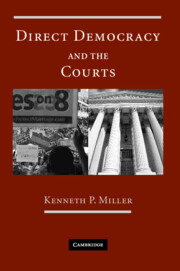Book contents
- Frontmatter
- Contents
- List of Tables and Figures
- Preface
- Introduction: A Clash of Rising Powers
- PART I THE QUEST FOR MAJORITY RULE
- PART II COUNTERING THE MAJORITY
- PART III THE MAJORITY STRIKES BACK
- Conclusion: A New Constitutional Equilibrium
- Appendix: Post-Election Initiative Invalidations
- References
- Index
- References
References
Published online by Cambridge University Press: 05 June 2012
- Frontmatter
- Contents
- List of Tables and Figures
- Preface
- Introduction: A Clash of Rising Powers
- PART I THE QUEST FOR MAJORITY RULE
- PART II COUNTERING THE MAJORITY
- PART III THE MAJORITY STRIKES BACK
- Conclusion: A New Constitutional Equilibrium
- Appendix: Post-Election Initiative Invalidations
- References
- Index
- References
- Type
- Chapter
- Information
- Direct Democracy and the Courts , pp. 245 - 264Publisher: Cambridge University PressPrint publication year: 2009



